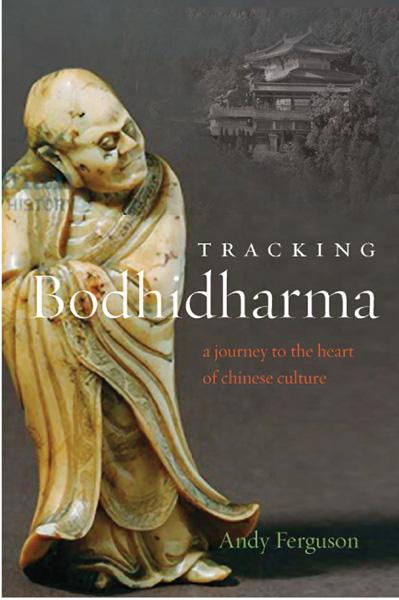Legend says that in the 6th century C.E., Bodhidharma, the First Ancestor of Chinese Zen, slipped across the Yangtze River on a blade of grass. Nearly a millennium and a half later, Japanese war planes whizzed in the early morning air over Pearl Harbor, Hawaii.
At first glance, these two events – one historical, one mythical – seem almost entirely unconnected. But in Tracking Bodhidharma, Zen scholar Andrew Ferguson makes the argument that the religious politics of Bodhidharma’s age changed the course of modern history.
Bodhidharma was an Indian teacher who spent approximately thirty years teaching Buddhism in China. He lived primarily around the Yangtze River, near some of China’s ancient capitals. Although he is credited with establishing Zen in China, the details of Bodhidharma’s life remain sketchy.
Ferguson set out to find physical evidence of Bodhidharma in modern China, and to learn more about the politics of Buddhism in ancient times. He recorded his discoveries in Tracking Bodhidharma, an enjoyable, if slightly frustrating, journey through the history of Chinese Zen. Through historical records, reconstruction of events, physical clues, and interviews with Buddhist clergy and laypeople, Ferguson re-creates the circumstances surrounding Bodhidharma’s life.
The Zen monk became an early proponent of the separation of church and state, Ferguson explains. Despite his proximity to royalty, Bodhidharma refused to serve the courts, arguing that monks should remain independent. The seeds of emperor worship in 20th-century Japan, Ferguson says, began in Bodhidharma’s era. The teacher’s resistance to the imperial cult made him an important opposition figure for future generations.
Ferguson has written a primer on Bodhidharma, but also on Chinese Zen and its lingering effects on Chinese society. Using clear, clean prose, he explains the tenets of Zen and how they have changed over time. Ferguson spends some time on religious practice, but he’s more interested in its real-life applications. At one point he visits modern Nanjing (former ancient capital of Southern Liang Dynasty), walking the blocks where the Bodhisattva Emperor Wu’s palace once stood. He goes into a coffee shop and asks the barista if she knows that the shop is built over a palace; the girl is shocked. Ferguson returns to these types of concrete anecdotes, grounding history and religion into the modern world.
Ferguson frames his story as a travelogue. He tours various temples, rivers, and cities that had some connection to Bodhidharma, searching for clues to the teacher’s historical existence. At times, the visits feel like temple-hopping, with each Dharma Hall bleeding into the next – especially because Ferguson rarely finds any evidence of Bodhidharma at the sites. Most have been forgotten, paved over, or lost in centuries of development. In Tianchang, Ferguson searches for Bodhidharma’s True Victory Temple. He finds only an unmarked well in the middle of the sidewalk, in front of an appliance store. Ferguson’s frustrations show how much of China’s historical record has been lost, and is probably irrecoverable.
At his best, Ferguson clearly and compellingly explains the history of Chinese Zen and its political ramifications. The sections where he delves into history – the emperor’s court, the in-fighting between various Buddhist sects – are the book’s strongest. He spends a long time on Emperor Wu, who ruled southern China from what is now Nanjing, in the 6th century. Seeking to spread Buddhism and firmly establish his rule, Emperor Wu married Buddhist vows – formerly reserved for monks or “home-leavers” – with imperial power. This process, later transferred to Korea and Japan, developed into the imperial cult that fueled the War in the Pacific centuries later, Ferguson argues. In contrast, Bodhidharma and his followers resisted royal appropriation of monastic practices. This marked a divide in the development of Zen as it spread throughout Asia.
The oddest thing about Tracking Bodhidharma is that its main character – Bodhidharma himself – remains elusive. A fragment of a prince’s poem may show that Bodhidharma met Emperor Wu; then again, it may simply be a poem. The lack of clues means that Ferguson must speculate on events. While based in records, his hypotheses sometimes seem flimsy; Ferguson’s book could have benefitted from footnotes. The historical Bodhidharma is always just up the path, just out of reach, buried in the rubble of history.
But the book still engages, because Ferguson’s preoccupation is not really Bodhidharma, after all, but the larger historical picture. How can politics hijack religion to legitimize terrible acts? How can an outwardly pacifist religion like Buddhism come to fuel nationalism and brutality? Ferguson’s expertise and passion for history help to illuminate these dilemmas. As a Buddhist himself, Ferguson grapples with his own practices, and questions Zen’s claims to pacifism. His internal struggles animate the story, bringing us closer to Bodhidharma’s legacy in modern China – if not to Bodhidharma himself.












